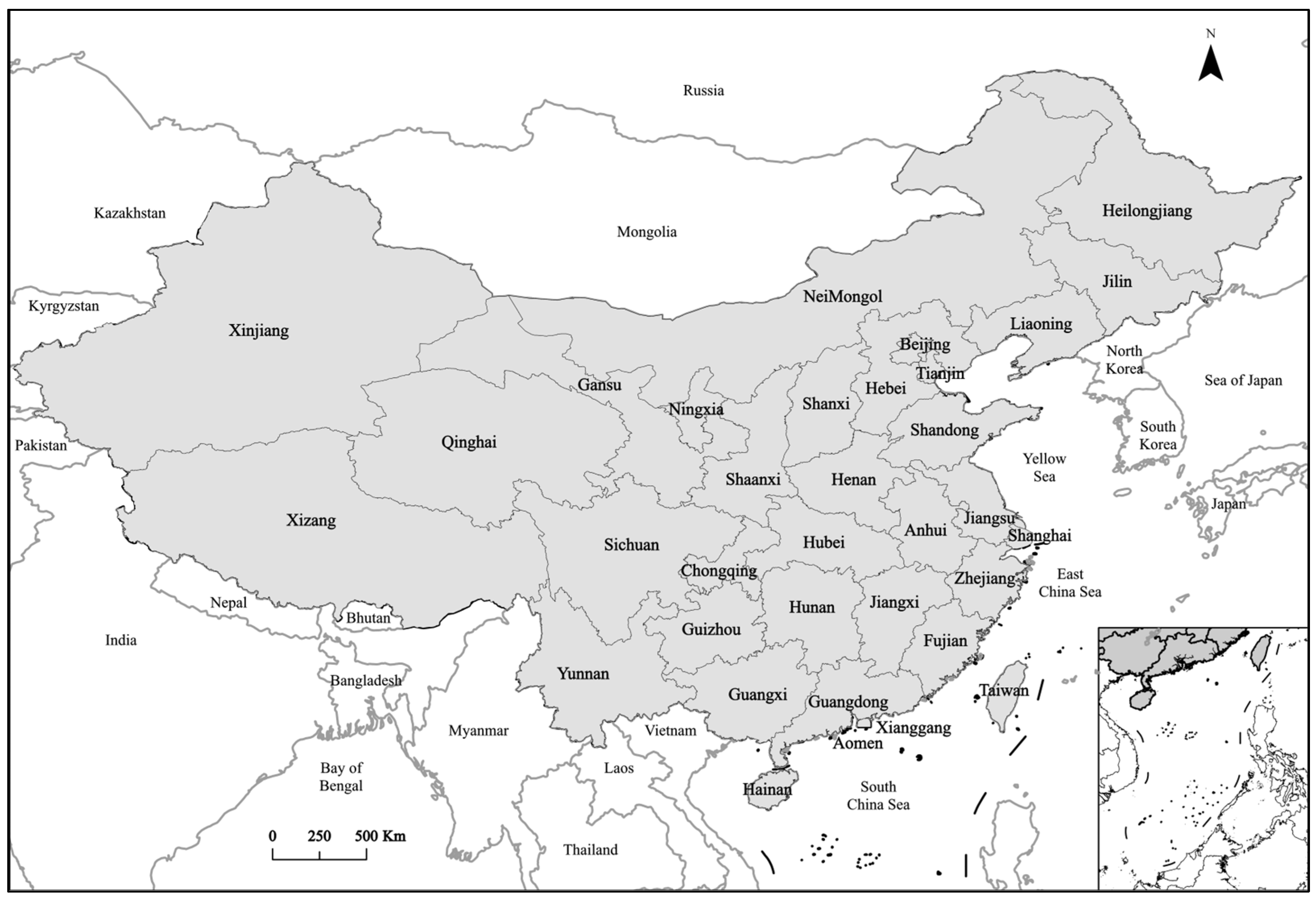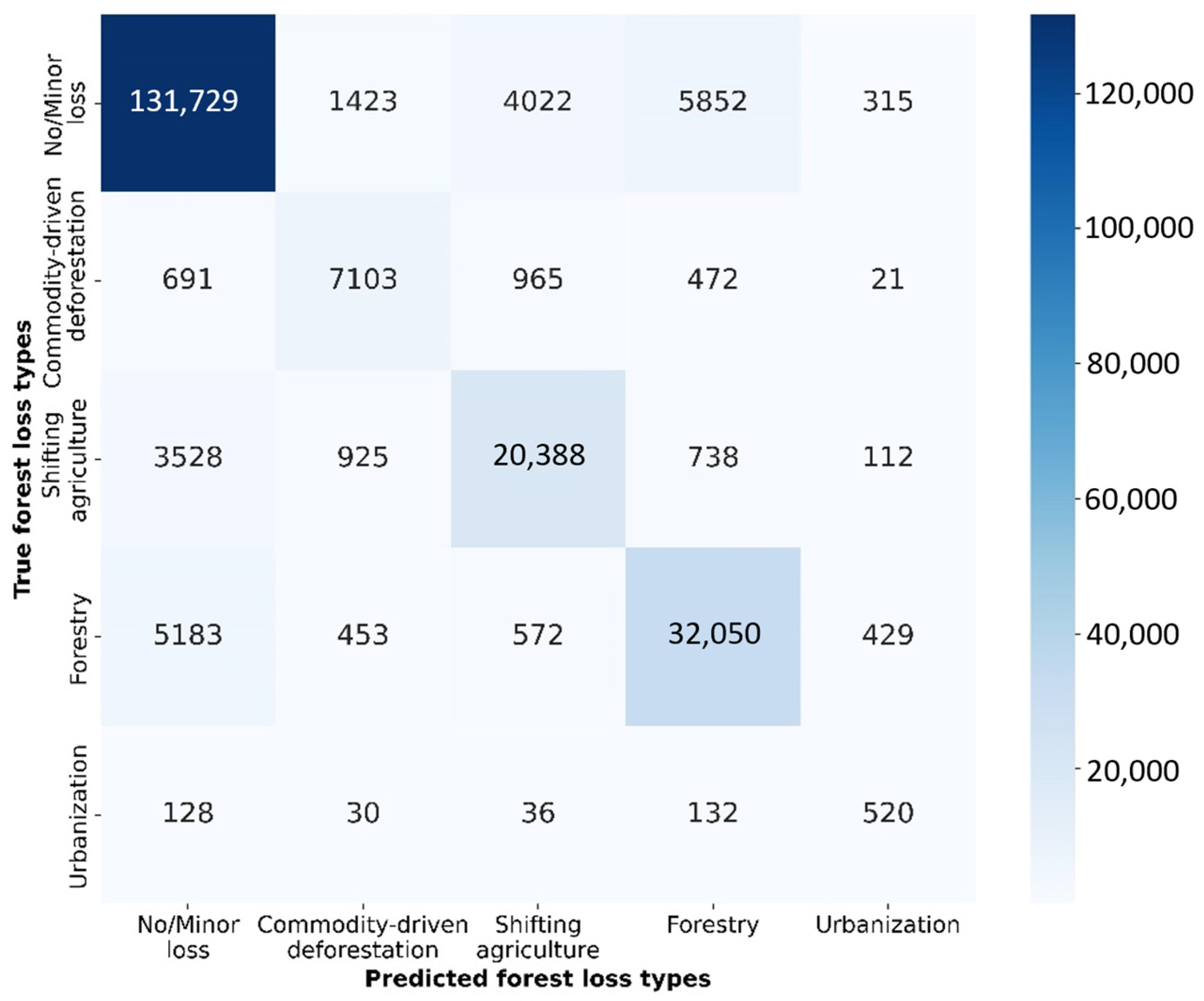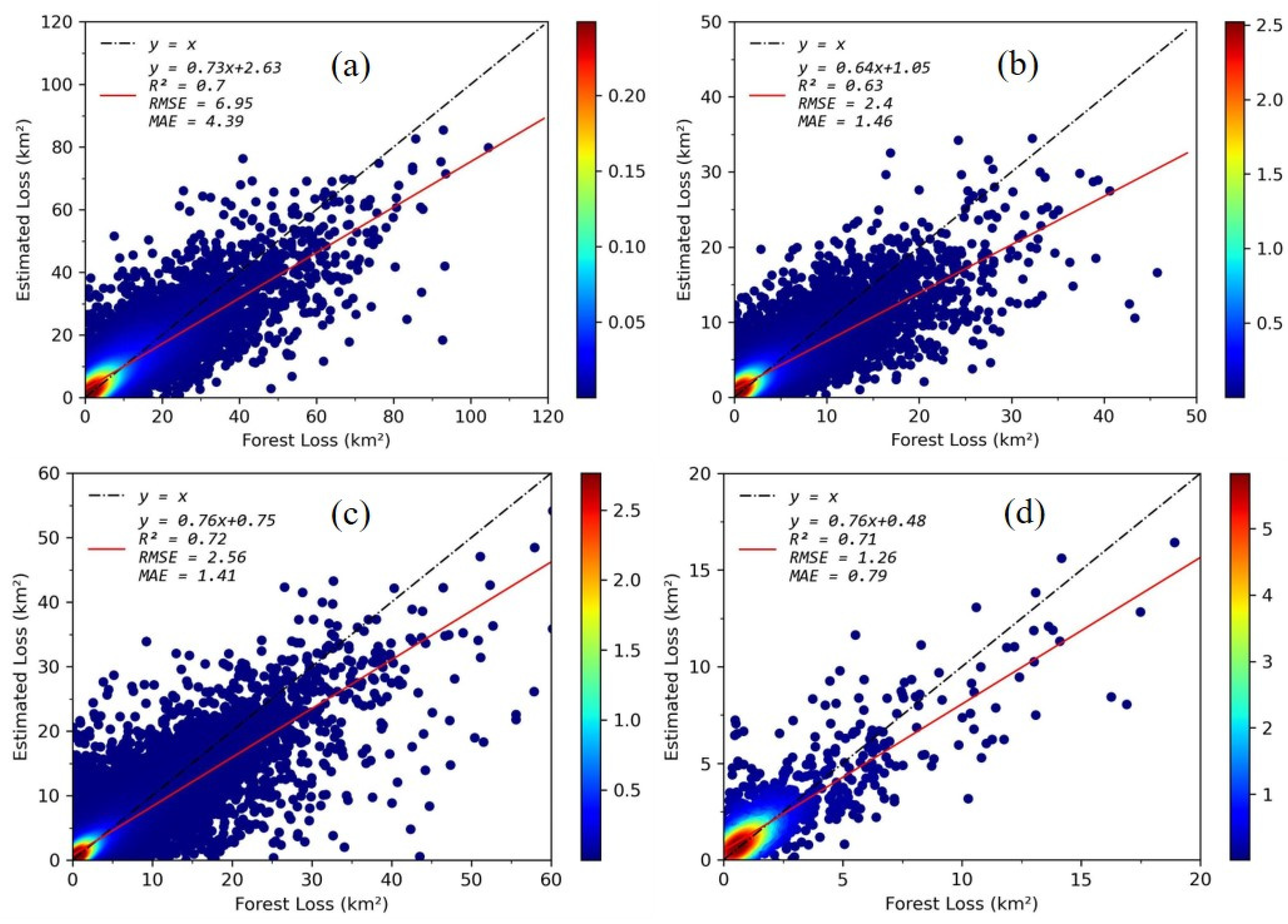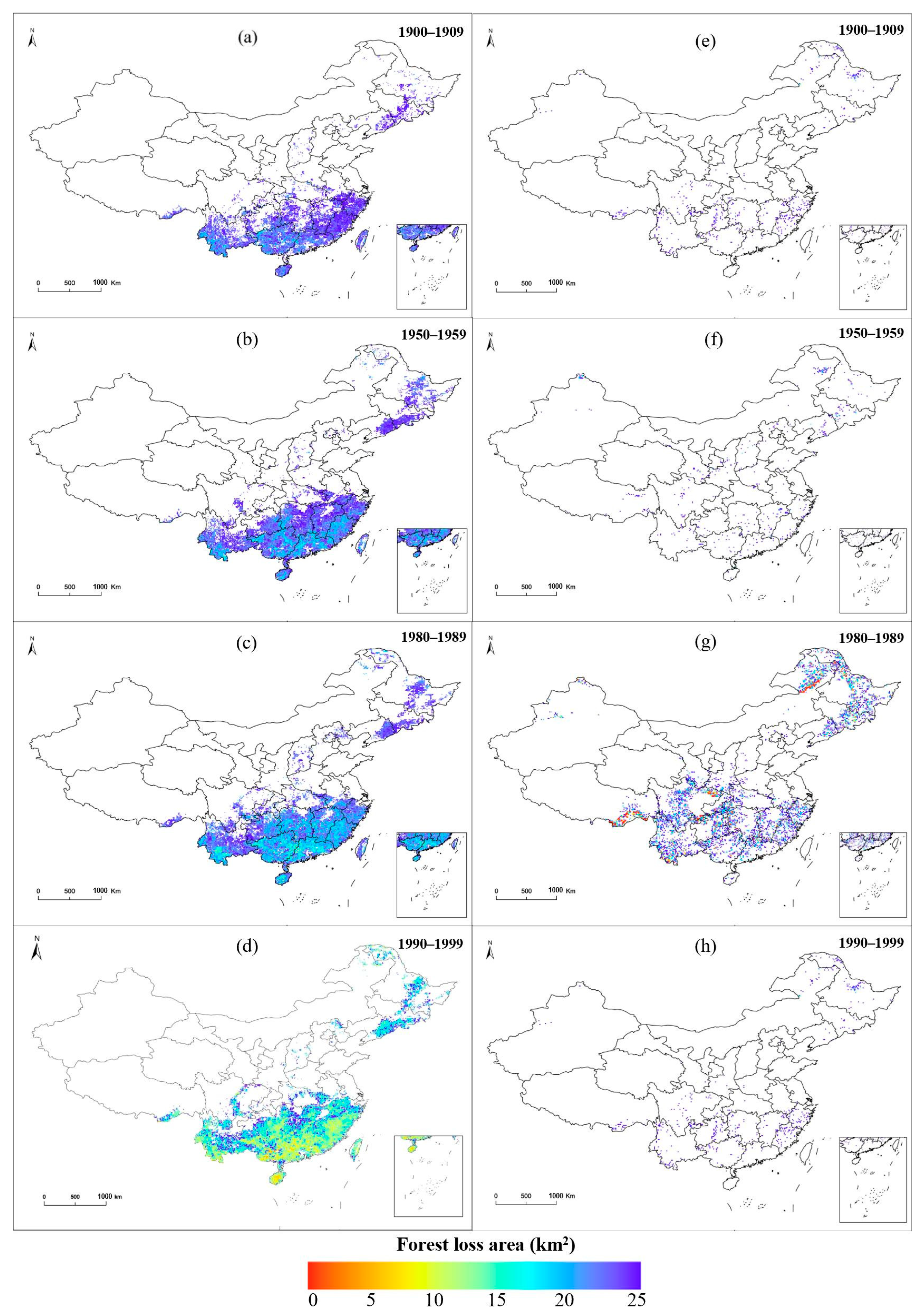Reconstruction of Human-Induced Forest Loss in China during 1900–2000
Abstract
:1. Introduction
2. Materials and Methods
2.1. Study Area
2.2. Data Sources
2.2.1. Forest Loss Data
2.2.2. Forest Loss Driver Data
2.2.3. Multisource Socioeconomic and Environmental Features
2.2.4. HYDE 3.2 and LUH2-GCB Data
2.2.5. Climate Data
2.2.6. Gross Domestic Product Data
2.2.7. Other Data
2.3. Reconstruction Model
2.4. Model Evaluation
3. Results
3.1. Model Evaluation Results
3.2. Predictions of Forest Loss in China from 1900–2000
3.2.1. Forest Loss Area Caused by Different Drivers
3.2.2. Spatial Distribution Patterns of Forest Loss
4. Discussion
4.1. Comparison with Other Studies
4.2. Spatiotemporal Changes in Forest Loss during Historical Periods
4.3. Applications and Limitations of This Study
5. Conclusions
Author Contributions
Funding
Data Availability Statement
Conflicts of Interest
Appendix A
| Name | Meaning | Implication | Source | Resolution |
|---|---|---|---|---|
| primf, primn, prim (_regional, _diff) | ratio of forested primary land, non-forested primary land, and primary land | abundance of forest resources | LUH2-GCB | 0.25° |
| secdn, secdf, secd (_regional, _diff) | ratio of potentially forested secondary land, potentially non-forested secondary land, and secondary land | abundance of forest resources | LUH2-GCB | 0.25° |
| c3ann, c3per, c4ann, c4per, crop (_regional, _diff) | ratio of C3 annual crops, C3 perennial crops, C4 annual crops, C4 perennial crops, and crops | pressure on forests from agriculture | LUH2-GCB | 0.25° |
| pastr (_regional, _diff) | ratio of managed pasture | pressure on forests from livestock farming | LUH2-GCB | 0.25° |
| range (_regional, _diff) | ratio of rangeland | pressure on forests from livestock farming | LUH2-GCB | 0.25° |
| urban (_regional, _diff) | ratio of urban land | pressure on forests from general human demand | LUH2-GCB | 0.25° |
| GDD | growing degree days | suitability of forest growth | Global bioclimatic indicators database | 0.5° |
| pre | precipitation | suitability of forest growth | Global bioclimatic indicators database | 0.5° |
| pop (_regional, _diff) | population | pressure on forests from general human demand | HYDE 3.2 | 0.0833° |
| land_use(_regional) | land use | general human impact | HYDE 3.2 | 0.0833° |
| GDP (_regional, _diff) | gross domestic production | regional development condition | Global GDP time-series dataset | 0.0833° |
| land_cover (_regional) | land cover | general human impact | MCD12C1 | 0.05° |
| tree_cover (_regional) | tree cover | abundance of forest resources | MOD44B | 250 m |
| elevation | elevation | forest growth suitability and potential for human disturbance | SRTM15+ | 0.00417° |
| relief | relief | forest growth suitability and potential for human disturbance | SRTM15+ | 0.00417° |
| city_access (_regional) | accessibility to cities | wood trade accessibility, intensity of human activity | Global city accessibility map | 0.00833° |

References
- Devaraju, N.; Bala, G.; Modak, A. Effects of large-scale deforestation on precipitation in the monsoon regions: Remote versus local effects. Proc. Natl. Acad. Sci. USA 2015, 112, 3257–3262. [Google Scholar] [CrossRef]
- Lee, X.; Goulden, M.L.; Hollinger, D.Y.; Barr, A.; Black, T.A.; Bohrer, G.; Bracho, R.; Drake, B.; Goldstein, A.; Gu, L.; et al. Observed increase in local cooling effect of deforestation at higher latitudes. Nature 2011, 479, 384–387. [Google Scholar] [CrossRef] [PubMed] [Green Version]
- Martinich, J.; Crimmins, A.; Beach, R.H.; Thomson, A.; McFarland, J. Focus on agriculture and forestry benefits of reducing climate change impacts. Environ. Res. Lett. 2017, 12, 060301. [Google Scholar] [CrossRef] [Green Version]
- Hua, F.; Wang, X.; Zheng, X.; Fisher, B.; Wang, L.; Zhu, J.; Tang, Y.; Yu, D.W.; Wilcove, D.S. Opportunities for biodiversity gains under the world’s largest reforestation programme. Nat. Commun. 2016, 7, 12717. [Google Scholar] [CrossRef] [Green Version]
- Veldkamp, E.; Schmidt, M.; Powers, J.S.; Corre, M.D. Deforestation and reforestation impacts on soils in the tropics. Nat. Rev. Earth Environ. 2020, 1, 590–605. [Google Scholar] [CrossRef]
- Bonan Gordon, B. Forests and Climate Change: Forcings, Feedbacks, and the Climate Benefits of Forests. Science 2008, 320, 1444–1449. [Google Scholar] [CrossRef] [Green Version]
- Wolff, N.H.; Zeppetello, L.R.V.; Parsons, L.A.; Aggraeni, I.; Battisti, D.S.; Ebi, K.L.; Game, E.T.; Kroeger, T.; Masuda, Y.J.; Spector, J.T. The effect of deforestation and climate change on all-cause mortality and unsafe work conditions due to heat exposure in Berau, Indonesia: A modelling study. Lancet Planet. Health 2021, 5, e882–e892. [Google Scholar] [CrossRef] [PubMed]
- Houghton, R.A.; Hobbie, J.E.; Melillo, J.M.; Moore, B.; Peterson, B.J.; Shaver, G.R.; Woodwell, G.M. Changes in the Carbon Content of Terrestrial Biota and Soils between 1860 and 1980: A Net Release of CO’2 to the Atmosphere. Ecol. Monogr. 1983, 53, 235–262. [Google Scholar] [CrossRef]
- Friedlingstein, P.; O’Sullivan, M.; Jones, M.W.; Andrew, R.M.; Hauck, J.; Olsen, A.; Peters, G.P.; Peters, W.; Pongratz, J.; Sitch, S.; et al. Global Carbon Budget 2020. Earth Syst. Sci. Data 2020, 12, 3269–3340. [Google Scholar] [CrossRef]
- Hansen, M.C.; Potapov, P.V.; Moore, R.; Hancher, M.; Turubanova, S.A.; Tyukavina, A.; Thau, D.; Stehman, S.V.; Goetz, S.J.; Loveland, T.R.; et al. High-Resolution Global Maps of 21st-Century Forest Cover Change. Science 2013, 342, 850–853. [Google Scholar] [CrossRef] [Green Version]
- Wang, H.; Lü, Z.; Gu, L.; Wen, C. Observations of China’s forest change (2000–2013) based on Global Forest Watch dataset. Biodivers. Sci. 2015, 23, 575–582. [Google Scholar] [CrossRef]
- Li, Y.; Sulla-Menashe, D.; Motesharrei, S.; Song, X.-P.; Kalnay, E.; Ying, Q.; Li, S.; Ma, Z. Inconsistent estimates of forest cover change in China between 2000 and 2013 from multiple datasets: Differences in parameters, spatial resolution, and definitions. Sci. Rep. 2017, 7, 8748. [Google Scholar] [CrossRef]
- Mikusinska, A.; Zawadzka, B.; Samojlik, T.; Jędrzejewska, B.; Mikusiński, G. Quantifying landscape change during the last two centuries in Białowieża Primeval Forest. Appl. Veg. Sci. 2013, 16, 217–226. [Google Scholar] [CrossRef]
- Kaim, D.; Kozak, J.; Kolecka, N.; Ziółkowska, E.; Ostafin, K.; Ostapowicz, K.; Gimmi, U.; Munteanu, C.; Radeloff, V.C. Broad scale forest cover reconstruction from historical topographic maps. Appl. Geogr. 2016, 67, 39–48. [Google Scholar] [CrossRef]
- Esser, G.; Lautenschlager, M. Estimating the change of carbon in the terrestrial biosphere from 18 000 BP to present using a carbon cycle model. Environ. Pollut. 1994, 83, 45–53. [Google Scholar] [CrossRef]
- Kaplan, J.O.; Krumhardt, K.M.; Zimmermann, N. The prehistoric and preindustrial deforestation of Europe. Quat. Sci. Rev. 2009, 28, 3016–3034. [Google Scholar] [CrossRef]
- Tian, H.; Banger, K.; Bo, T.; Dadhwal, V.K. History of land use in India during 1880–2010: Large-scale land transformations reconstructed from satellite data and historical archives. Glob. Planet. Chang. 2014, 121, 78–88. [Google Scholar] [CrossRef] [Green Version]
- He, F.; Li, S.; Zhang, X. A spatially explicit reconstruction of forest cover in China over 1700–2000. Glob. Planet. Chang. 2015, 131, 73–81. [Google Scholar] [CrossRef]
- Yang, X.; Jin, X.; Xiang, X.; Fan, Y.; Shan, W.; Zhou, Y. Reconstructing the spatial pattern of historical forest land in China in the past 300 years. Glob. Planet. Chang. 2018, 165, 173–185. [Google Scholar] [CrossRef] [Green Version]
- Liu, M.; Tian, H. China’s land cover and land use change from 1700 to 2005: Estimations from high-resolution satellite data and historical archives. Glob. Biogeochem. Cycles 2010, 24, GB3003. [Google Scholar] [CrossRef]
- Leite, C.C.; Costa, M.H.; Soares-Filho, B.S.; de Barros Viana Hissa, L. Historical land use change and associated carbon emissions in Brazil from 1940 to 1995. Glob. Biogeochem. Cycles 2012, 26, GB2011. [Google Scholar] [CrossRef]
- FAO. FRA 2020 Remote Sensing Survey; FAO: Rome, Italy, 2022; Volume 186, 92p. [Google Scholar] [CrossRef]
- Curtis, P.G.; Slay, C.M.; Harris, N.L.; Tyukavina, A.; Hansen, M.C. Classifying drivers of global forest loss. Science 2018, 361, 1108–1111. [Google Scholar] [CrossRef] [PubMed]
- Imai, N.; Furukawa, T.; Tsujino, R.; Kitamura, S.; Yumoto, T. Factors affecting forest area change in Southeast Asia during 1980–2010. PLoS ONE 2018, 13, e0197391. [Google Scholar] [CrossRef] [PubMed] [Green Version]
- Mather, A.S. The Forest Transition. Area 1992, 24, 367–379. [Google Scholar]
- Perz, S.G. Grand Theory and Context-Specificity in the Study of Forest Dynamics: Forest Transition Theory and Other Directions. Prof. Geogr. 2007, 59, 105–114. [Google Scholar] [CrossRef]
- Zhao, F.; Huang, C.; Zhu, Z. Use of Vegetation Change Tracker and Support Vector Machine to Map Disturbance Types in Greater Yellowstone Ecosystems in a 1984–2010 Landsat Time Series. IEEE Geosci. Remote Sens. Lett. 2015, 12, 1650–1654. [Google Scholar] [CrossRef]
- Geiger, T. Continuous national gross domestic product (GDP) time series for 195 countries: Past observations (1850–2005) harmonized with future projections according to the Shared Socioeconomic Pathways (2006–2100). Earth Syst. Sci. Data 2018, 10, 847–856. [Google Scholar] [CrossRef] [Green Version]
- Weiss, D.J.; Nelson, A.; Gibson, H.S.; Temperley, W.; Peedell, S.; Lieber, A.; Hancher, M.; Poyart, E.; Belchior, S.; Fullman, N.; et al. A global map of travel time to cities to assess inequalities in accessibility in 2015. Nature 2018, 553, 333–336. [Google Scholar] [CrossRef]
- Klein Goldewijk, K.; Beusen, A.; Doelman, J.; Stehfest, E. Anthropogenic land use estimates for the Holocene—HYDE 3.2. Earth Syst. Sci. Data 2017, 9, 927–953. [Google Scholar] [CrossRef] [Green Version]
- Chini, L.; Hurtt, G.; Sahajpal, R.; Frolking, S.; Klein Goldewijk, K.; Sitch, S.; Ganzenmüller, R.; Ma, L.; Ott, L.; Pongratz, J.; et al. Land-use harmonization datasets for annual global carbon budgets. Earth Syst. Sci. Data 2021, 13, 4175–4189. [Google Scholar] [CrossRef]
- Wouters, H.; Berckmans, J.; Maes, R.; Vanuytrecht, E.; De Ridder, K. Global Bioclimatic Indicators from 1950 to 2100 Derived from Climate Projections. Copernicus Climate Change Service (C3S) Climate Data Store (CDS). 2021. Available online: https://cds.climate.copernicus.eu/cdsapp#!/dataset/10.24381/cds.a37fecb7?tab=overview (accessed on 13 March 2022).
- Tozer, B.; Sandwell, D.T.; Smith, W.H.F.; Olson, C.; Beale, J.R.; Wessel, P. Global Bathymetry and Topography at 15 Arc Sec: SRTM15+. Earth Space Sci. 2019, 6, 1847–1864. [Google Scholar] [CrossRef]
- Friedl, M.; Sulla-Menashe, D. MCD12C1 MODIS/Terra+Aqua Land Cover Type Yearly L3 Global 0.05Deg CMG V006. Available online: https://lpdaac.usgs.gov/products/mcd12c1v006/ (accessed on 10 March 2022).
- DiMiceli, C.; Carroll, M.; Sohlberg, R.; Kim, D.; Kelly, M.; Townshend, J. MOD44B MODIS/Terra Vegetation Continuous Fields Yearly L3 Global 250m SIN Grid V006. Available online: https://lpdaac.usgs.gov/products/mod44bv006/ (accessed on 15 April 2022).
- Ke, G.; Meng, Q.; Finley, T.; Wang, T.; Chen, W.; Ma, W.; Ye, Q.; Liu, T.-Y. Lightgbm: A highly efficient gradient boosting decision tree. Adv. Neural Inf. Process. Syst. 2017, 30, 3149–3157. [Google Scholar]
- Yang, X.; Jin, X.; Lin, Y.; Han, J.; Zhou, Y. Review on China’s spatially-explicit historical land cover datasets and reconstruction methods. Prog. Geogr. 2016, 35, 159–172. [Google Scholar] [CrossRef]
- Li, S.; Yang, Q. Socioeconomic factors determining China‘s deforestation rates. Geogr. Res. 2000, 19, 1–7. [Google Scholar]
- Winkler, K.; Fuchs, R.; Rounsevell, M.; Herold, M. Global land use changes are four times greater than previously estimated. Nat. Commun. 2021, 12, 2501. [Google Scholar] [CrossRef] [PubMed]
- Yu, Z.; Ciais, P.; Piao, S.; Houghton, R.A.; Lu, C.; Tian, H.; Agathokleous, E.; Kattel, G.R.; Sitch, S.; Goll, D.; et al. Forest expansion dominates China’s land carbon sink since 1980. Nat. Commun. 2022, 13, 5374. [Google Scholar] [CrossRef] [PubMed]
- The Chinese State Forest Administration. China Forest Resources Report (1999–2013)—The 6th National Forest Survey; China Forestry Publishing House: Beijing, China, 2009. [Google Scholar]
- Ewers, R.M. Interaction effects between economic development and forest cover determine deforestation rates. Glob. Environ. Chang. 2006, 16, 161–169. [Google Scholar] [CrossRef]
- Rudel, T.K.; Coomes, O.T.; Moran, E.; Achard, F.; Angelsen, A.; Xu, J.; Lambin, E. Forest transitions: Towards a global understanding of land use change. Glob. Environ. Chang. 2005, 15, 23–31. [Google Scholar] [CrossRef]
- Mather, A.S. Recent Asian forest transitions in relation to foresttransition theory. Int. For. Rev. 2007, 9, 491–502. [Google Scholar] [CrossRef]
- Fang, J.; Chen, A.; Peng, C.; Zhao, S.; Ci, L. Changes in forest biomass carbon storage in China between 1949 and 1998. Science 2001, 292, 2320–2322. [Google Scholar] [CrossRef]
- Li, X.; Zhao, Y. Forest Transition, Agricultural Land Marginalization and Ecological Restoration. China Popul. Resour. Environ. 2011, 21, 91–95. [Google Scholar]
- Lambin, E.F.; Meyfroidt, P. Global land use change, economic globalization, and the looming land scarcity. Proc. Natl. Acad. Sci. USA 2011, 108, 3465–3472. [Google Scholar] [CrossRef] [PubMed]
- Estoque, R.C.; Dasgupta, R.; Winkler, K.; Avitabile, V.; Johnson, B.A.; Myint, S.W.; Gao, Y.; Ooba, M.; Murayama, Y.; Lasco, R.D. Spatiotemporal pattern of global forest change over the past 60 years and the forest transition theory. Environ. Res. Lett. 2022, 17, 084022. [Google Scholar] [CrossRef]
- Grez, A.; Bustamante, R.; Simonetti, J.; Fahrig, L. Landscape ecology, deforestation, and forest fragmentation: The case of the ruil forest in Chile. In Landscape Ecology as a Tool for Sustainable Development in Latin America; Editorial Universitaria: Santiago, Chile, 1998. [Google Scholar]
- Fahrig, L.; Grez, A.A. Population spatial structure, human-caused landscape changes and species survival. Rev. Chil. De Hist. Nat. 1996, 69, 5–13. [Google Scholar]
- Wei, J.; Li, Z.; Pinker, R.T.; Wang, J.; Sun, L.; Xue, W.; Li, R.; Cribb, M. Himawari-8-derived diurnal variations in ground-level PM 2.5 pollution across China using the fast space-time Light Gradient Boosting Machine (LightGBM). Atmos. Chem. Phys. 2021, 21, 7863–7880. [Google Scholar] [CrossRef]







| Forest Loss Type | Precision | Recall | F1-Score | Number of Samples | Accuracy |
|---|---|---|---|---|---|
| No or minor loss | 0.92 | 0.93 | 0.93 | 141,259 | 0.88 |
| Commodity driven deforestation | 0.77 | 0.72 | 0.74 | 9934 | |
| Shifting agriculture | 0.79 | 0.78 | 0.79 | 25,983 | |
| Forestry | 0.83 | 0.82 | 0.82 | 39,244 | |
| Urbanization | 0.61 | 0.37 | 0.46 | 1397 | |
| Macro average | 0.78 | 0.72 | 0.75 | 217,817 | - |
| Weighted average | 0.88 | 0.88 | 0.88 | 217,817 | - |
Disclaimer/Publisher’s Note: The statements, opinions and data contained in all publications are solely those of the individual author(s) and contributor(s) and not of MDPI and/or the editor(s). MDPI and/or the editor(s) disclaim responsibility for any injury to people or property resulting from any ideas, methods, instructions or products referred to in the content. |
© 2023 by the authors. Licensee MDPI, Basel, Switzerland. This article is an open access article distributed under the terms and conditions of the Creative Commons Attribution (CC BY) license (https://creativecommons.org/licenses/by/4.0/).
Share and Cite
Zhang, Y.; Ding, J.; Wang, Y.; Zhang, Y.; Liu, Y.; Zhang, L.; Ariken, M.; Wulan, T.; Huang, W.; Li, Y.; et al. Reconstruction of Human-Induced Forest Loss in China during 1900–2000. Remote Sens. 2023, 15, 3831. https://doi.org/10.3390/rs15153831
Zhang Y, Ding J, Wang Y, Zhang Y, Liu Y, Zhang L, Ariken M, Wulan T, Huang W, Li Y, et al. Reconstruction of Human-Induced Forest Loss in China during 1900–2000. Remote Sensing. 2023; 15(15):3831. https://doi.org/10.3390/rs15153831
Chicago/Turabian StyleZhang, Yanwen, Jiaqi Ding, Yueyao Wang, Yajuan Zhang, Yinglu Liu, Lijin Zhang, Muhadaisi Ariken, Tuya Wulan, Wenli Huang, Yan Li, and et al. 2023. "Reconstruction of Human-Induced Forest Loss in China during 1900–2000" Remote Sensing 15, no. 15: 3831. https://doi.org/10.3390/rs15153831
APA StyleZhang, Y., Ding, J., Wang, Y., Zhang, Y., Liu, Y., Zhang, L., Ariken, M., Wulan, T., Huang, W., Li, Y., & Li, S. (2023). Reconstruction of Human-Induced Forest Loss in China during 1900–2000. Remote Sensing, 15(15), 3831. https://doi.org/10.3390/rs15153831









